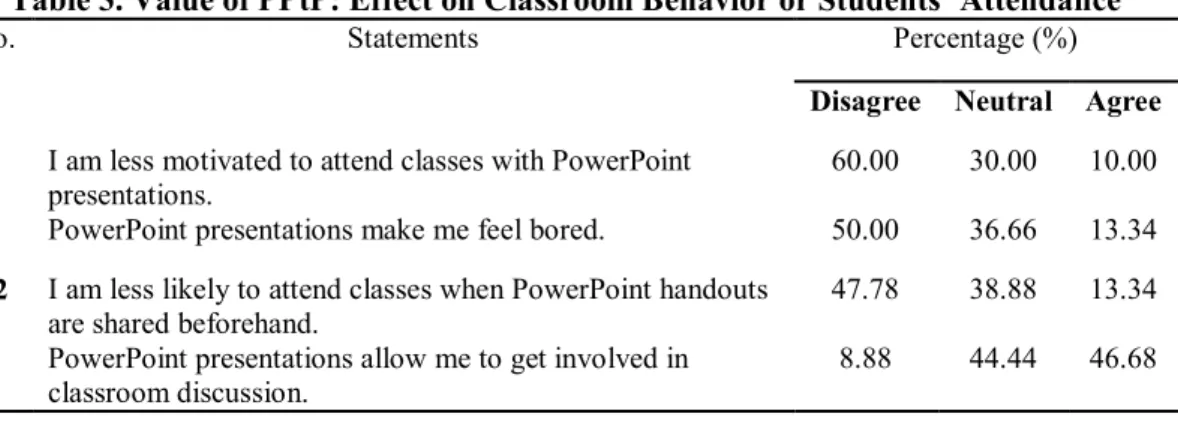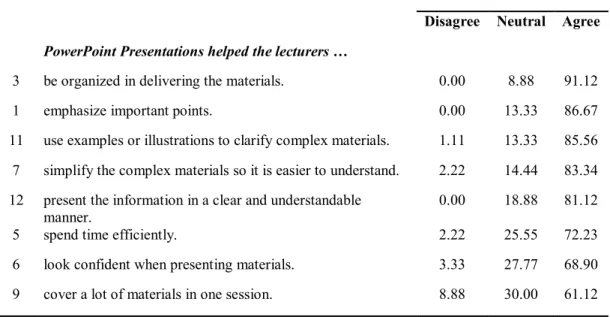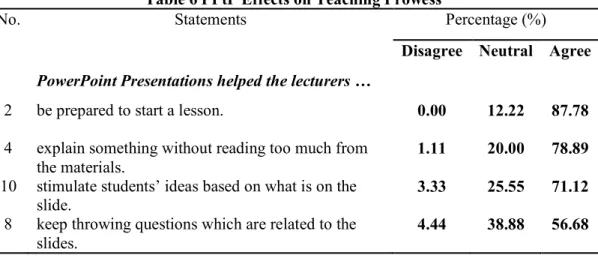Sanata Dharma University, Yogyakarta, Indonesia
87
ANALYZING THE VALUES AND EFFECTS OF POWERPOINT PRESENTATIONS
K. M. Widi Hadiyanti and Widya
Atma Jaya Catholic University
widi.hadiyanti@gmail.com and widwidwid13@gmail.com
DOI: doi.org/10.24071/llt.2018.Suppl2108
Received 16 January 2018; revised 5 March 2018; accepted 19 May 2018
Abstract
PowerPoint Presentation (PPtP) is now quite common in many aspects of life, not only at schools (Yilmazel-Sahin, 2007). It facilitates events in various ways owing to its practicality (Craig & Armenic, 2006). In classes, it provides advantages for both students and teachers, but it may be problematic as well (Davies et al., 2009; Oommen; Taylor, 2012). Therefore, Howard & Conway (1985) recommended verifying if students’ viewpoints may maximize its contribution for class empowerment. This study focused on how students appreciated the values of PPP and how it affected lecturers. It involved 90 students responding to a questionnaire asking their standpoint about the use of PPP including commentary and suggestion. Results revealed that in general, participants out looked positively towards PPP and its impact to teachers. It aided students and teacher in the learning-teaching process, although it was occasionally blamed as not engaging or even boring.
Keywords: value, effect, PowerPoint Presentation
Introduction
Technology advancement has a large impact on us making many sectors of our life become easier. PowerPoint is one of the technologies widely used anywhere, from public to private aspects such as in court rooms, daycare centers, churches, even in personal ceremonies and parties (Yilmazel-Sahin, 2007). Thomas (2014) put forward that during the last decade, Microsoft estimated around 30 million PowerPoint presentations made by world-wide business professionals daily.
88
skills (Schcolnik & Kol, 1999). It is because PPtP facilitates the learning processes to be more engaging with clearer and more structured instruction in manageable time (Susskind, 2004; Craig & Amernic, 2006; Oommen, 2012; Thomas, 2014) and not just to keep the students occupied (Szabo & Hastings, 2000; Shyamlee & Phil, 2012). It may facilitate the class with games, practices and drills (Fisher, 2003), to review the materials, and to present students’ projects (Yilmazel-Sahin, 2007 & Oommen, 2012).
Regardless of the advantageous contribution PPtP shares in education, there were weaknesses as it needs time in the preparation. Taylor (2012) adds that oversimplification might happen when covering huge materials. This may manipulate students’ understanding (Khoury & Mattar, 2012) making the students passive and avoid taking part in class (Davies et al., 2009), moreover, when the teacher is too busy with the materials and the tool, ignoring the students (Taylor, 2012). Despite its positive and negative points, students’ standpoint about the use of PowerPoint presentations in classes is meaningful (King, 2010) in establishing significant development in the learning process (Struyven et al. , 2005) to reflect and evaluate teaching performance (Howard & Conway 1985).
There were studies done conforming Daniel’s idea that perception towards PowerPoint presentation was devastatingly positive. Students favoured teachers employing PowerPoint presentation. Frey and Birnbaum (2002) in their examination regarding students’ points of view about values of PPt used by their lecturers demonstrated that students considered PPtP aided them in learning, and assisted lectures be more structured. This was supported by investigations made by Davies et al. (2009), Anh (2011), & Oommen (2012). Nevertheless, Sewasew (2015)’s research comparing PowerPoint presentation to traditional lecture concerning the students’ attitude to the understandability and the effectiveness of the materials found that students like traditional teaching better. It was because the students thought that traditional way highlighted more on the learning process. The investigator deduced that there might be disruption of technology in studying. Therefore, there should be good judgment in making use of it in classes.
This research investigated the values, and effects of PowerPoint presentations from the students’ general viewpoints, handout availability, effect on classroom behavior, and the design. Further, it also examined the effects of PPtP on teachers’ presentation skills, and teaching prowess. It would be beneficial for those who are involved in ELT since it provides insights about using PowerPoint presentations in grammar classes. According to Corbeil (2007), the nature of grammar courses is theory-based, and there have been an increasing number of grammar teachers making use of PowerPoint presentation to put emphasis on grammatical rules.
Method
89
availability of hand-outs, effect on students’ attendance, and the design of PPtP. Other twelve points enquired students’ opinion on how PPtP facilitated teachers’ presentation skills, and teaching prowess. The first and second parts were analyzed in percentage after being sorted out into three: ‘neutral’, ‘agree’, and ‘disagree’. Meanwhile, the third one consisted of three open ended questions requesting students what they liked and disliked along with their suggestions, resulting in lists of comments and suggestions developed into some qualitative classifications. The illustrations of the analysis outcome are in the following tables.
Findings and Discussion
The first table demonstrates the students’ general viewpoints. This is similar to Craig and Amernic’s (2006) findings stating that students liked their classes with PPtP. Students agreed that PPtP made the lessons organized. Consequently, it was easier for them to follow the lessons (Frey & Birnbaum, 2002). The presence of PPtP in classes aided them to get the emphasis of the lessons holding their attention, yielding in positive attitude. It can be deduced that the students found advantageous experience from learning with PPT in their grammar courses.
Table 1. Value of PPtP: General Viewpoint
No. Statements Percentage (%)
Disagree Neutral Agree
6 PowerPoint presentations make the lesson organized. 0.00 20.00 80.00
10 PowerPoint presentations help to emphasize key points. 0.00 21.11 78.89
11 I have a positive attitude towards PowerPoint presentations. 1.11 23.33 75.56
1 PowerPoint presentations hold my attention. 7.77 25.55 66.88
Next is the students’ opinion on handout availability, which was found beneficial in helping them to learn for examinations and facilitating for taking better notes. The finding is corresponding to Craig and Amernic’s (2006) statement that students liked joining classes using PowerPoint presentation with handout. Yet, several students responded neutrally and negatively about it, which somehow could be inferred that using PPtP and handout in class should not be done too often.
Table 2. Value of PPtP: Handouts Availability
No. Statements Percentage (%)
Disagree Neutral Agree
2 Handouts printed from PowerPoint presentations help me
study for course exams. 3.33 17.77 78.90
90
Dealing with the students’ attendance in classes, more than half felt motivated when PPtP was utilized. However, only half of them admitted that they were interested in PowerPoint presentation; more than one third gave neutral responses; whereas a small number felt bored with it. When the teachers distributed handouts beforehand, it no longer had big influence on students’ attendance. Students might think that handout could be a reason to skip classes. Even so, it may possibly be said that the use of PowerPoint presentations in class was still impactful if not so frequently used; as what Clark (cited in Sewasew et al., 2015) affirmed that the comforts of technology like PPtP tended to fade away. It is as well interesting to note that less than half of the students got involved in classroom discussion when PPtP was used. The other students might think that there was no difference whether it was used or not. Additional assumption was these students were the typical “watch and listen” students as labeled by Sewasew et al. (2015) referring to those who simply watched what the teachers demonstrated on the slides.
Table 3. Value of PPtP: Effect on Classroom Behavior or Students’ Attendance
No. Statements Percentage (%)
Disagree Neutral Agree
9 I am less motivated to attend classes with PowerPoint
presentations. 60.00 30.00 10.00
5 PowerPoint presentations make me feel bored. 50.00 36.66 13.34
12 I am less likely to attend classes when PowerPoint handouts are shared beforehand.
47.78 38.88 13.34
7 PowerPoint presentations allow me to get involved in
classroom discussion. 8.88 44.44 46.68
The following result of analysis is regarding PPtP design. Most students had the same opinion that bullet points assisted them, no one disagreed. This was corresponding to Oommen’s (2012) declaration that bullet points aided students recognize the main ideas, and directed them what to focus on. Besides, the visual images of PowerPoint presentations helped them (Daniels, 1999) recall the contents during exams. To sum up, both bullet points and visuals facilitated the students to understand the materials easily.
Table 4 Value of PPtP Design
No. Statements Percentage (%)
Disagree Neutral Agree
3 Bullet points in PowerPoint presentations help me identify
the main ideas. 0.00 18.88 81.12
8 Visual images in PowerPoint lectures help me recall content during exams.
91
How PowerPoint presentations affected teacher’s presentation skills and teaching prowess is presented in the subsequent tables. It is remarkable to find that no one disagreed, meaning that most participants agreed, to the ideas that PowerPoint presentations assisted the lecturers of Structure classes to be organized in delivering the materials, and in emphasizing important points. Majority of them also acknowledged the fact that PPtP supported teachers in using examples and illustrations to clarify complex materials, as well as presenting the lessons clearly and understandably as they simplified complex materials. It confirmed the results of researches employed by Frey & Birnbaum (2002), and Oommen (2012). Furthermore, students thought that teachers spent time efficiently which conformed to Davies et al.’s (2009) study. Dealing with the teacher’s confidence in presenting the materials, more than two third of the subjects showed their agreement. This is in accordance with Yilmazel-Sahin (2007) arguing PPtP enabled the teachers to teach confidently as they possessed guidance on the slides. Nonetheless, material coverage occupied the lowest position. These might be that the materials were too overwhelming to cover. This is matched to Miltenoff’s (as cited in Oommen, 2012) argument. Even so, generally, from the students’ view, teachers showed good presentation skills.
Table 5. PPtP Effects on Teacher’s Presentation Skills
No. Statements Percentage (%)
Disagree Neutral Agree
PowerPoint Presentations helped the lecturers …
3 be organized in delivering the materials. 0.00 8.88 91.12
1 emphasize important points. 0.00 13.33 86.67
11 use examples or illustrations to clarify complex materials. 1.11 13.33 85.56
7 simplify the complex materials so it is easier to understand. 2.22 14.44 83.34
12 present the information in a clear and understandable
manner. 0.00 18.88 81.12
5 spend time efficiently. 2.22 25.55 72.23
6 look confident when presenting materials. 3.33 27.77 68.90
9 cover a lot of materials in one session. 8.88 30.00 61.12
92
Table 6 PPtP Effects on Teaching Prowess
No. Statements Percentage (%)
Disagree Neutral Agree
PowerPoint Presentations helped the lecturers…
2 be prepared to start a lesson. 0.00 12.22 87.78
4 explain something without reading too much from the materials.
1.11 20.00 78.89
10 stimulate students’ ideas based on what is on the
slide. 3.33 25.55 71.12
8 keep throwing questions which are related to the
slides. 4.44 38.88 56.68
The result of the analysis about what the students liked about PowerPoint presentations in grammar classes supported studies utilized byFrey and Birnbaum (2002), Craig and Amernic (2006), Yilmazel-Sahin (2007), as well as Oommen (2012). Students considered PPtP less boring and helped them understand the lessons. It aided clarify and emphasize the materials. With bullet points and visuals, it offered a simpler way to learn complex materials as it was easier to read and grab comprehensively. On the other hand, some felt bored and sleepy. A possible intriguing reason was that other courses used PowerPoint presentations as well causing it overused and started to make them fed up. It conformed to Clark’s (as cited in Sewasew et al., 2015) argument that the ease of having PPtP in class reduced with time. Those uninterested students might also assume that with PPtP, they did not need to listen to the teacher (Khoury & Mattar, 2012). The handout provided was perceived valuable to review since it summarized the lessons providing an effective learning environment and enabled the students to participate in the process. The findings on what students liked about PPtP matched to Frey and Birnbaum’s (2002) study.
Subsequently is what students did not like about PowerPoint presentations. Some gave no suggestions because they actually appreciated the teachers’ preparation. Visually, they disliked PPtP with plain design, small fonts, too many words or sentences, no underline, no different color, and few illustrations in it. It was believed that any emphases or illustrations (bold, italic, underline, pictures, charts, schemes, etc.)might assist the acquisition of the lessons (Oommen, 2012), so teachers should be able to create PPtP consisting clear, effective, and efficient messages to make students understand the lessons better. This suggestion matched Corbeil’s (2007) claim that those emphases made the grammatical rules more noticeable. Students also expected to see a more interesting and interactive PPtP design by adding animations to highlight certain ideas since PPtP is visual.
93
materials and unconsciously ignored students’ involvement. However, recommendation is offered to the lecturers to avoid redundant explanations by simplifying the materials in the form of points for the idea of PPtP is ‘points with power’. Even though, putting more attention to the material coverage, not leaving behind the less important ones, is also important. Furthermore, ‘guided-note’ handout may be useful to minimize oversimplification. Neef, McCord, and Ferreri (as cited in Yilmazel-Sahin, 2007) suggested to provide blank spaces to encourage students take notes making the learning process become more alive and meaningful.
Conclusion
According to Ozaslan and Maden (2013), PowerPoint presentation utility in English Language Teaching is increasing since it is obviously useful. Therefore, it cannot be denied that everyone, including teachers and students, feels the advantages of having PPtP in classes, as what the analysis found. On the whole, students felt that PowerPoint presentations helped them learn through organized lessons, emphasis on key points, and attention keeping. In addition, inserting bullet points and illustrations assisted students acquire and understand the lessons. Whereas, handouts aided them review the materials and facilitate note taking. Nevertheless, the presence of PPtP did no longer affect some students’ motivation to attend classes as learning with PPtP started to become boring for them, and did not really give them chance to partake in classroom discussion.
Regarding how PowerPoint presentations affected teachers’ presentation skills, students commonly thought that their teachers showed good presentation skills when they taught using PPtP with good material organization, clear presentation, important point emphases, illustration usage, complex material simplification, and efficient time spent; confidence, and material coverage. Students also thought that their teachers were prepared, and able to explain without referring back to the slides, to stimulate students’ idea, and to keep throwing questions while teaching. PowerPoint presentation and the presenters are inseparable. Restating Daniels’ (1999) statement, students’ responses towards this issue was overwhelmingly positive. In spite of the boredom it sometimes caused, in line with the students’ responses to the questionnaire, the teachers’ ways in delivering the materials using it matters more.
94
References
Abdellatif, Z. (2015). Exploring students’ perceptions of using PowerPoint in enhancing their active participation in the EFL classroom: Action research study. Journal of Literature, Languages and Linguistics, 55, 36-39.
Ahmad, J. (2012). English Language Teaching (ELT) and integration of media technology. Social and Behavioral Sciences, 47(2012), 924-929.
Anh, N. T. Q. (2011). Efficacy of PowerPoint presentations: students’ perception. Proceedings of the 3rd International Conference of Teaching and Learning (pp. 1-9). Malaysia.
Bartsch, R. A., & Cobern, K. M. (2003). Effectiveness of PowerPoint presentations in lectures. Computers & Education, 41(2003), 77-86.
Corbeil, G. (2007). Can PowerPoint presentations effectively replace textbooks and blackboards for teaching grammar? Do students find them an effective learning tool? CALICO Journal, 24(3), 631-656.
Craig, R. J., & Amernic, J. H. (2006). PowerPoint presentation technology and the dynamics of teaching. Innov High Educ, (31), 147-160.
Daniels, L. (1999). Introducing technology in the classroom: PowerPoint as a first step. Journals of Computing in Higher Education, 10(2), 42-46.
Davies, T. L., Lavin, A. M., & Korte, L. (2009). Student perceptions of how technology impacts the quality of instruction and learning. Journal of Instructional Pedagogies, 2-16.
Fisher, D. L., (2003). Using PowerPoint for ESL teaching. The Internet TESL Journal, 9(4). Retrieved from http://iteslj.org/Techniques/Fisher-PowerPoint.html
Frey, B. A., & Birnbaum D. J. (2002). Learners’ perceptions on the value of PowerPoint in lectures. Education Resources Information Center, 1-9.
Howard, G. S., & Conway, C. G. (1985). Construct validity of measures of college teaching effectiveness. Journal of Educational Psychology, 77(2), 187-196. Khoury, R. M., & Mattar, D. M. (2012). PowerPoint in accounting classrooms:
Constructive or destructive? International Journal of Business and Social Science, 3(10), 240-259.
King, L. (2010). The science of psychology: An appreciative view. New York: McGraw Hill.
Morgan-Thomas, Maxine. (2014). Acting out in class: the group role-play advantage over PowerPoint presentation. Journal of Legal Studies in Business.
Oommen, A. (2012). Teaching English as a global language in smart classrooms with PowerPoint presentation. English Language Teaching, 5(12), 54-61.
Ozaslan, E. N., & Maden, Z, (2013). The use of PowerPoint presentations in the Department of Foreign Language Education at Middle East Technical University. Middle Eastern & African Journal of Educational Research, (2), 38-45.
Schcolnik, M., & Kol, S. (1999). Using presentation software to enhance language learning. The Internet TESL Journal, 5(3). Retrieved from http://iteslj.org/Techniques/Schcolnik-PresSoft.html
Sewasew, D., Mengestie, M., & Abate, G. (2015). A comparative study on PowerPoint presentation and traditional lecture method in material understandability, effectiveness and attitude. Educational Research and Reviews, 10(2), 234-243. Shyamlee, S. D., & Phil, M. (2012). Use of Technology in English language teaching and
95
Struyven, K., Dochy, F., & Janssens, S. (2005). Students’ perceptions about evaluation and assessment in higher education: A review. Assessment & Evaluation in Higher Education, 30(4), 325-341.
Susskind, J. E. (2004). PowerPoint’s power in the classroom: Enhancing students’ self-efficacy and attitudes. Computers & Education, 45(2005), 203-215.
Szabo, A., & Hastings, N. (2000). Using IT in the undergraduate classroom: Should we replace the blackboard with PowerPoint? Computers & Education, 35(2000), 175-187.
Taylor, G. (2012). Making a place for PowerPoint in EFL classrooms. OnCUE Journal, 6(1), 41-51.



